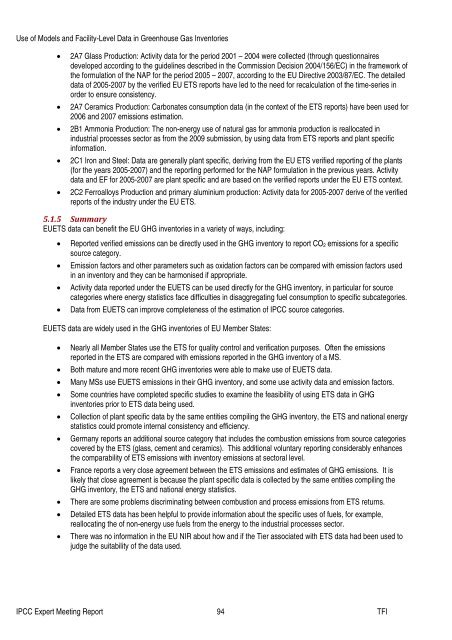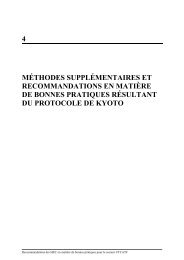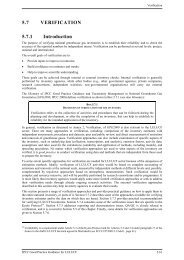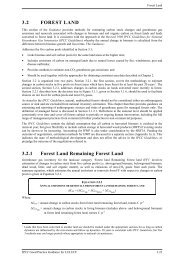Use of Models and Facility-Level Data in Greenhouse Gas Inventories
Use of Models and Facility-Level Data in Greenhouse Gas Inventories
Use of Models and Facility-Level Data in Greenhouse Gas Inventories
Create successful ePaper yourself
Turn your PDF publications into a flip-book with our unique Google optimized e-Paper software.
<strong>Use</strong> <strong>of</strong> <strong>Models</strong> <strong>and</strong> <strong>Facility</strong>-<strong>Level</strong> <strong>Data</strong> <strong>in</strong> <strong>Greenhouse</strong> <strong>Gas</strong> <strong>Inventories</strong><br />
• 2A7 Glass Production: Activity data for the period 2001 – 2004 were collected (through questionnaires<br />
developed accord<strong>in</strong>g to the guidel<strong>in</strong>es described <strong>in</strong> the Commission Decision 2004/156/EC) <strong>in</strong> the framework <strong>of</strong><br />
the formulation <strong>of</strong> the NAP for the period 2005 – 2007, accord<strong>in</strong>g to the EU Directive 2003/87/EC. The detailed<br />
data <strong>of</strong> 2005-2007 by the verified EU ETS reports have led to the need for recalculation <strong>of</strong> the time-series <strong>in</strong><br />
order to ensure consistency.<br />
• 2A7 Ceramics Production: Carbonates consumption data (<strong>in</strong> the context <strong>of</strong> the ETS reports) have been used for<br />
2006 <strong>and</strong> 2007 emissions estimation.<br />
• 2B1 Ammonia Production: The non-energy use <strong>of</strong> natural gas for ammonia production is reallocated <strong>in</strong><br />
<strong>in</strong>dustrial processes sector as from the 2009 submission, by us<strong>in</strong>g data from ETS reports <strong>and</strong> plant specific<br />
<strong>in</strong>formation.<br />
• 2C1 Iron <strong>and</strong> Steel: <strong>Data</strong> are generally plant specific, deriv<strong>in</strong>g from the EU ETS verified report<strong>in</strong>g <strong>of</strong> the plants<br />
(for the years 2005-2007) <strong>and</strong> the report<strong>in</strong>g performed for the NAP formulation <strong>in</strong> the previous years. Activity<br />
data <strong>and</strong> EF for 2005-2007 are plant specific <strong>and</strong> are based on the verified reports under the EU ETS context.<br />
• 2C2 Ferroalloys Production <strong>and</strong> primary alum<strong>in</strong>ium production: Activity data for 2005-2007 derive <strong>of</strong> the verified<br />
reports <strong>of</strong> the <strong>in</strong>dustry under the EU ETS.<br />
5.1.5 Summary<br />
EUETS data can benefit the EU GHG <strong>in</strong>ventories <strong>in</strong> a variety <strong>of</strong> ways, <strong>in</strong>clud<strong>in</strong>g:<br />
• Reported verified emissions can be directly used <strong>in</strong> the GHG <strong>in</strong>ventory to report CO 2 emissions for a specific<br />
source category.<br />
• Emission factors <strong>and</strong> other parameters such as oxidation factors can be compared with emission factors used<br />
<strong>in</strong> an <strong>in</strong>ventory <strong>and</strong> they can be harmonised if appropriate.<br />
• Activity data reported under the EUETS can be used directly for the GHG <strong>in</strong>ventory, <strong>in</strong> particular for source<br />
categories where energy statistics face difficulties <strong>in</strong> disaggregat<strong>in</strong>g fuel consumption to specific subcategories.<br />
• <strong>Data</strong> from EUETS can improve completeness <strong>of</strong> the estimation <strong>of</strong> IPCC source categories.<br />
EUETS data are widely used <strong>in</strong> the GHG <strong>in</strong>ventories <strong>of</strong> EU Member States:<br />
• Nearly all Member States use the ETS for quality control <strong>and</strong> verification purposes. Often the emissions<br />
reported <strong>in</strong> the ETS are compared with emissions reported <strong>in</strong> the GHG <strong>in</strong>ventory <strong>of</strong> a MS.<br />
• Both mature <strong>and</strong> more recent GHG <strong>in</strong>ventories were able to make use <strong>of</strong> EUETS data.<br />
• Many MSs use EUETS emissions <strong>in</strong> their GHG <strong>in</strong>ventory, <strong>and</strong> some use activity data <strong>and</strong> emission factors.<br />
• Some countries have completed specific studies to exam<strong>in</strong>e the feasibility <strong>of</strong> us<strong>in</strong>g ETS data <strong>in</strong> GHG<br />
<strong>in</strong>ventories prior to ETS data be<strong>in</strong>g used.<br />
• Collection <strong>of</strong> plant specific data by the same entities compil<strong>in</strong>g the GHG <strong>in</strong>ventory, the ETS <strong>and</strong> national energy<br />
statistics could promote <strong>in</strong>ternal consistency <strong>and</strong> efficiency.<br />
• Germany reports an additional source category that <strong>in</strong>cludes the combustion emissions from source categories<br />
covered by the ETS (glass, cement <strong>and</strong> ceramics). This additional voluntary report<strong>in</strong>g considerably enhances<br />
the comparability <strong>of</strong> ETS emissions with <strong>in</strong>ventory emissions at sectoral level.<br />
• France reports a very close agreement between the ETS emissions <strong>and</strong> estimates <strong>of</strong> GHG emissions. It is<br />
likely that close agreement is because the plant specific data is collected by the same entities compil<strong>in</strong>g the<br />
GHG <strong>in</strong>ventory, the ETS <strong>and</strong> national energy statistics.<br />
• There are some problems discrim<strong>in</strong>at<strong>in</strong>g between combustion <strong>and</strong> process emissions from ETS returns.<br />
• Detailed ETS data has been helpful to provide <strong>in</strong>formation about the specific uses <strong>of</strong> fuels, for example,<br />
reallocat<strong>in</strong>g the <strong>of</strong> non-energy use fuels from the energy to the <strong>in</strong>dustrial processes sector.<br />
• There was no <strong>in</strong>formation <strong>in</strong> the EU NIR about how <strong>and</strong> if the Tier associated with ETS data had been used to<br />
judge the suitability <strong>of</strong> the data used.<br />
IPCC Expert Meet<strong>in</strong>g Report 94 TFI

















